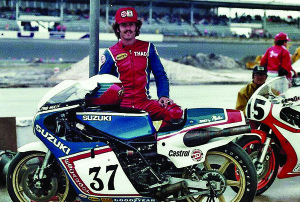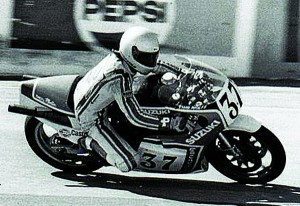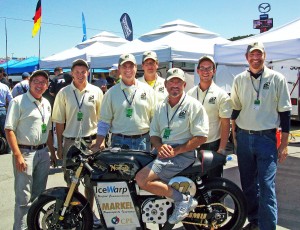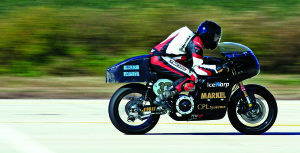(This article was originally published in the July 2012 issue of Rider Magazine.)
Brian Richardson got his first motorcycle in 1969 at the age of 10. It was a 2.5-horsepower minibike from the Carousel department store in Richmond, Virginia. Within days, another boy challenged him to a race. The other bike had 5 horsepower. What to do? While cutting grass, Brian accidentally flipped the governor on the family lawnmower, causing the engine to race. So he removed the governor from his minibike and won the challenge.
Fast forward almost 40 years. Living on a sheep farm with his wife Betty, in the idyllic Blue Grass Valley in the Alleghany Mountains of Virginia, Richardson exercised his knack for tinkering. He worked on tractor engines, welded a metal sheep chute and repaired railings. Anticipating his 50th birthday, he told Betty he wanted to buy a motorcycle. Not just any bike—he had his heart set on a café racer from the English company Norton. There was a problem, though: “You couldn’t buy a Norton in America at that time.” Betty had the answer: “Why don’t you build one?”
Knowing that Norton once made a model called the Electra 400, named for the electric start feature, which was new in 1963, Richardson had an idea. Electric cars were now available. Could he substitute an electric motor for the standard gasoline bike engine? In early 2009, with snow still blanketing the pasture, he got to work. His shop was the upper level of a sheep barn built in the 1860s. He took an old Norton Featherbed frame and stripped it. He bolted on an AC induction motor from Thunderstruck in California, a lithium-polymer battery pack from Stark Power in North Carolina, added carbon fiber wheels and regenerative braking, and wired up his machine.
“I had three goals when I started,” Richardson says. “The bike had to do the ton—go at least one hundred miles per hour. It needed enough range to be practical. And it had to be safe.”

In pursuit of the third goal, he chose an air-cooled motor of 118 volts, 62 horsepower and 120 lb-ft of torque. Other inventors are trying motors with more power and higher voltage, which may pose a risk of serious injury in a crash. Moto-Electra has been timed as fast as 127 mph, and it goes up to 80 miles on a charge. To recharge, you plug it into a wall socket through a DC converter.
As it happens, Richardson is also an attorney with an office in Monterey, the seat of Highland County, population 2,300. To be on the safe side, he contacted Norton about the use of the name Moto-Electra. They sent a letter giving him permission.
Richardson assembled a team. In addition to Martin Koebler, his battery supplier, he brought in Dr. Robert Prins, an assistant professor of engineering at James Madison University in Harrisonburg, Virginia. A motorcyclist himself, Prins heads the Alternative Fuels Vehicle Lab at JMU. He taught Richardson about electronics. They have taken college students to races, and the students are building their own bikes. John Wild, who built his own electric bike in Ohio, also joined the Moto-Electra team and Prins at JMU. Richardson admired the bodywork of Peter Williams and adapted it.
The team found some corporate sponsors. The donations from Ice Warp, Markel Insurance and CPL Systems were small, a few thousand dollars each, but enough. The whole operation was run on a shoestring, with Richardson putting in endless hours. His invention was workable, and it might be attractive to others. Moto-Electra is a sportbike with excellent handling and zero emissions, environmentally friendly, maintenance-free, with the potential for urban use. And it is silent. Richardson says: “You get all the benefits of riding—speed, visibility, the breeze in your face—and now you can even hear the birds in the trees.”

Demonstration was good, and promotion was a factor, but Richardson wanted to race. With no experience on the track and an anxious wife, he contacted people out of the blue, looking for a rider. Mark Tuttle, editor of Rider, passed his request on to Thad Wolff. Known as a strong competitor in AMA superbike racing, Wolff had also raced vintage bikes. He even rebuilt a 1958 BSA Super Rocket to race on Catalina Island in early 2010. Currently, he is a motorcycle race instructor at Willow Springs, north of Los Angeles. Within hours of getting the email, Wolff phoned to say he was in. To hear Richardson tell the story, he is still getting over the excitement.
In June 2009, soon after completing his prototype, Richardson took it to the Mid-Ohio Sports Car Course, in Lexington, Ohio. Wolff asked only for a plane ticket. Accommodations were a small tent. With Wolff in the saddle, they showed off at the TTXGP Vintage Grand Prix. After all, it was a 1951 bike, updated. They followed this debut in September with an appearance at the Mason Dixon Dragway in Hagerstown, Maryland, where they set the ¼-mile record for their class.
In May 2010, Richardson loaded his bike on a trailer hitched to his vintage Volvo wagon. He drove across the United States to Sonoma, California, for the first-ever all-electric meet at Infineon Raceway. He was up against teams with big budgets and modern bike frames. But the old Norton was fast, topping 120 mph and holding firm in third place. Then Moto-Electra coasted to a stop. A tiny screw had fallen out of the motor. “We were heartbroken, but now we knew that we had a chance. We would be ready for them next time.”
The next month, at Road America in Elkhart Lake, Wisconsin, Wolff took pole position and rode to a third-place finish. The track announcer recognized Wolff’s name on the roster from a previous victory. Thirty years before, Wolff had won there, when the announcer was a fellow racer. It was a sweet homecoming.

In July 2010, Moto-Electra entered the Mosport TTXGP in Toronto, Canada, an all-electric race. Here they took second place. They followed it next month with a third-place finish at the Virginia International Raceway in Alton, Virginia. In October, they met again at the Barber Motorsports Park in Birmingham, Alabama. For the first time in history, an electric bike was pitted against gasoline models. With low expectations, Moto-Electra was gridded dead last in the starting lineup. Wolff steadily gained on the other riders, until he led the pack in the last lap. With no one even close, he took first place.
Early in 2011, Richardson and his team started from scratch to build a new bike. They also moved from the unheated sheep barn to a shop at the Highland Center, a former high school in Monterey. With the help of Framecrafters in Chicago, they recreated the Norton Featherbed chassis. They mounted a larger motor and controller, beefed up the brakes, shocks and wheels, and went with a classic Norton body. All they kept from the prototype was the Kokam lithium-polymer battery, which Richardson claims is the best there is.
At Infineon in May 2011, while Wolff was running the qualifying trials, an electrical connection worked loose. The motor abruptly stopped, and the motorcycle crashed. Bitterly disappointed, Richardson was about to pack up when Wolff gave him a pep talk. “Crashes are part of racing,” he said. Working feverishly overnight, they found the problem and jury-rigged a fix. The next day, Wolff rode to second place.
In July that year, Moto-Electra entered the international TTXGP/FIM event, held during MotoGP weekend at Mazda Raceway, in Laguna Seca, California. This was a more demanding competition, including the top electric racing bikes from around the world. Again they were plagued by mechanical problems, but Wolff managed to place seventh in a field of 13. A race followed at Miller Motorsports Park, near Salt Lake City, Utah, in September—the final race of the season that gave the team its all-important second-place and best finish for the year in the TTXGP series. The year ended in October at Maxton Mile, in Maxton, North Carolina, for the East Coast Timing Association trials. Wolff was unable to make the trek, so Richardson rode Moto-Electra. Despite being a heavier man, he set the ECTA land speed record for electric bikes.

In January 2012, Moto-Electra exhibited at the International Motorcycle Show in Washington, DC, the only electric bike on the floor. It also appeared in March at Wofford College in Spartanburg, South Carolina, Richardson’s alma mater. The sponsor money has run out for racing this year, so Richardson is focusing on education. He has no proprietary secrets, and he says that many people can do what he did: “This is the golden age for electric vehicle racing and development.”
Admitting that limited range is a problem for Moto-Electra, Richardson says: “We want to establish a coast-to-coast race, to work on range issues and reliability. The goal is to cross the United States on our electric bike in under four days. This will challenge engineers to beat our mark and advance the technology.” As for production: “We need to find a partner to take us to the next level.”
For Thad’s part, he says, “I thought this was a neat, fun and new experience, and I was proud to help Brian pursue his dream with his unique electric racer.”
Looking back on three years of racing, Richardson says: “Moto-Electra finished 2011 ranked second in North America for the TTXGP season. The best part was my friendship with Thad Wolff.”
Related: http://www.ridermag.wpengine.com/style/electric-motorcycle/2012-electric-motorcycles-from-brammo-and-zero.htm.








To see such a diverse group of folks get together simply for the joy of creating and riding ….renews my faith in people, education and even lawyers!